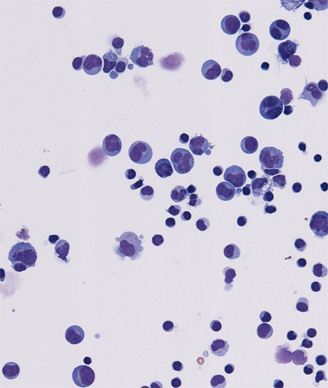Extended Rituximab Plus R-CHOP Best in Elderly, Poor-Prognosis DLBCL
Elderly patients with poor-prognosis DLBCL may derive the most benefit from treatment with extended rituximab plus 6 cycles of R-CHOP on a 14-day schedule.
CSF cytology of a diffuse large B-cell lymphoma; source: Wikimedia Commons

Elderly patients with poor-prognosis diffuse large B-cell lymphoma (DLBCL) may derive the most benefit from treatment with extended rituximab plus 6 cycles of R-CHOP on a 14-day schedule, according to the results of the SMARTE-R study published in the Journal of Clinical Oncology.
“The results of SMARTE-R, a large phase II study with 189 patients, strongly suggest that outcome with R-CHOP-14 can be improved with a modified rituximab schedule with no increase in toxicity or cost, resulting in the best results ever reported for elderly patients with DLBCL to date, to our knowledge,” wrote Michael Pfreundschuh, MD, of Saarland University Medical School, Germany, and colleagues.
The researchers assigned 189 patients aged 61 to 80 years to receive rituximab 375 mg/m2 plus 6 cycles of R-CHOP (rituximab, cyclophosphamide, doxorubicin, vincristine, and prednisone) on a 14-day schedule. They then compared these patients to a group of patients that received 6 cycles of R-CHOP on a 14-day schedule combined with eight 2-week applications of rituximab taken from the RICOVER-60 trial.
Overall, 85% of patients in the study had complete response/unconfirmed complete response, with a 90% response seen in patients with good-prognosis and an 81% response rate for those with poor prognosis. With a median follow-up of 37 months, the event-free survival was 71% for the entire cohort, 75% for good-prognosis patients, and 67% for poor-prognosis patients. The 3-year overall survival was 84% for all patients, 88% for good prognosis, and 80% for poor prognosis.
“During the first 4 weeks, rituximab levels in SMARTE-R with the loading schedule of two applications before the first CHOP cycle were higher than in RICOVER-60, where the highest trough serum levels were not observed until the last application on day 98,” the researchers wrote. “Despite the worse prognostic profile of the SMARTE-R compared with the RICOVER population, there were no significant differences with respect to grade 3 and 4 toxicities, except for leukocytopenia and infections, which were less frequent in SMARTE-R.”
When comparing outcomes to RICOVER, the researchers found that the longer rituximab exposure time in the SMARTE-R trial resulted in a better 3-year event-free survival (67% vs 54%) and overall survival (80% vs 67%) when comparing the patients with poor prognosis.
Based on these results, the researchers suggested that a direct comparison of the two rituximab schedules is warranted.